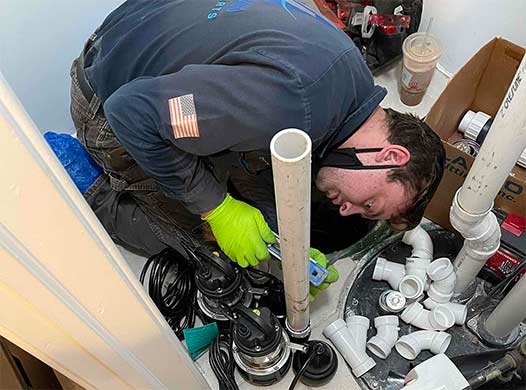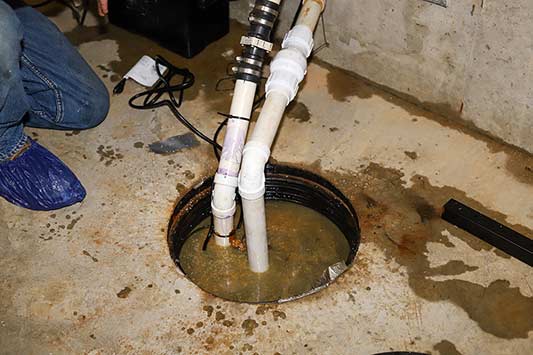
A sump pump is an essential device for preventing basement flooding and water damage. It works by removing excess water that accumulates in the sump pit and pumping it away from your home’s foundation. Like any mechanical device, sump pumps have a lifespan, and eventually, they will need to be replaced. But how do you know when it’s the right time to replace your sump pump?
Signs of a Failing Sump Pump
While sump pumps are designed to be reliable, they can wear out or experience malfunctions over time. Being aware of the signs of a failing sump pump is crucial to prevent flooding and water damage. Here are some common indicators that it may be time to replace your sump pump:
- Frequent Cycles: If your sump pump is turning on and off more frequently than usual, it could be a sign of a problem. This may indicate that the pump is struggling to keep up with the water flow, which could be due to a failing motor or a clogged discharge pipe.
- Loud Noises: Unusual noises such as grinding, rattling, or clanking coming from your sump pump are not a good sign. These noises could be an indication of worn-out or damaged components that need to be replaced.
- Excessive Vibrations: Sump pumps should operate smoothly and quietly. If you notice excessive vibrations or shaking, it could be a sign of worn-out bearings or a misaligned impeller.
- Visible Rust or Corrosion: Inspect your sump pump regularly for signs of rust or corrosion. Rusty or corroded components can compromise the pump’s performance and reliability.
- Sump Pump Age: Sump pumps typically have a lifespan of around 10 years. If your pump is approaching or exceeding this timeframe, it’s a good idea to start considering a replacement, even if it hasn’t shown any signs of failure yet.
Importance of Timely Replacement
Knowing when to replace your sump pump is crucial to ensure the continued protection of your basement from flooding. If a sump pump fails during a heavy rainstorm or when snow is melting, it can lead to significant water damage, mold growth, and costly repairs. By replacing your sump pump before it fails, you can avoid these potential risks and maintain a dry and safe basement.
Hiring a Professional to Assess Your Sump Pump
If you are unsure about the condition of your sump pump or if it is time for a replacement, it’s recommended to hire a professional plumber to assess the situation. A qualified plumber or sump pump specialist can inspect your sump pump, identify any underlying issues, and determine whether a replacement is necessary. They can also help you select a new sump pump that suits your specific needs and install it correctly.

A qualified plumber or sump pump specialist can inspect your sump pump, identify any underlying issues, and determine whether a replacement is necessary.
Choosing the Right Replacement Sump Pump
When selecting a replacement sump pump, there are several factors to consider:
- Pump Type: There are two main types of sump pumps: pedestal and submersible. Pedestal pumps have the motor located above the sump pit, while submersible pumps are designed to be submerged in water. Depending on the depth of your sump pit and your specific requirements, you can choose the most suitable type.
- Pump Capacity: The pump capacity, usually measured in gallons per minute (GPM) or gallons per hour (GPH), determines how quickly the sump pump can remove water. Consider the size of your basement and the potential water inflow to select a sump pump with an appropriate capacity.
- Battery Backup: In areas prone to power outages, a sump pump with a battery backup system installation is highly recommended. It ensures that your sump pump continues to function even during power failures, providing you with uninterrupted protection.
- Quality and Warranty: Invest in a high-quality sump pump from a reputable manufacturer. Check for warranties and customer reviews to ensure reliability and durability.
Maintaining Your Sump Pump
Proper maintenance can extend the lifespan of your sump pump and keep it functioning optimally. Here are some maintenance tips:
- Clean Sump Pit: Regularly remove any debris or sediment that accumulates in the sump pit to prevent clogging and pump strain.
- Test the Pump: Test your sump pump periodically by pouring water into the sump pit. Ensure that the pump activates and effectively removes the water.
- Check Discharge Pipe: Inspect the discharge pipe for any blockages or obstructions. Clear away any debris that may impede the flow of water.
- Replace Backup Battery: If your sump pump has a battery backup system, test and replace the battery as needed to ensure it functions during power outages.
In Summary
Knowing when to replace your sump pump is essential for maintaining a dry and safe basement. Be vigilant for signs of a failing pump, and consider contacting a professional plumber if you’re uncertain about its condition. Selecting the right replacement sump pump and performing regular maintenance will help you avoid potential flooding and water damage, providing you with peace of mind during heavy rainfalls and melting snow.